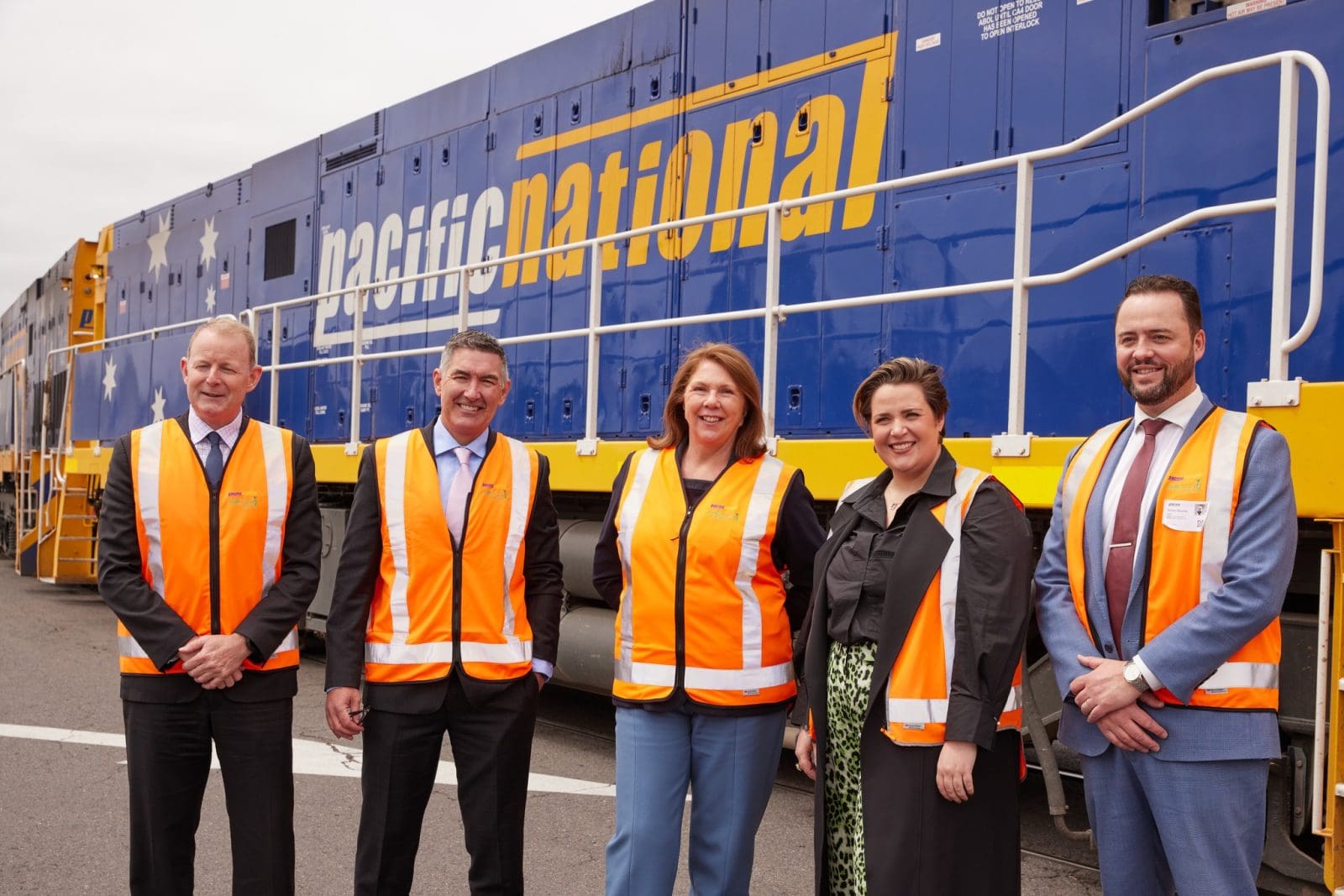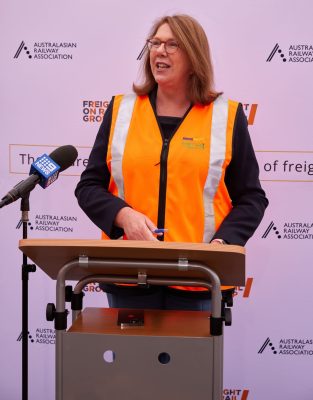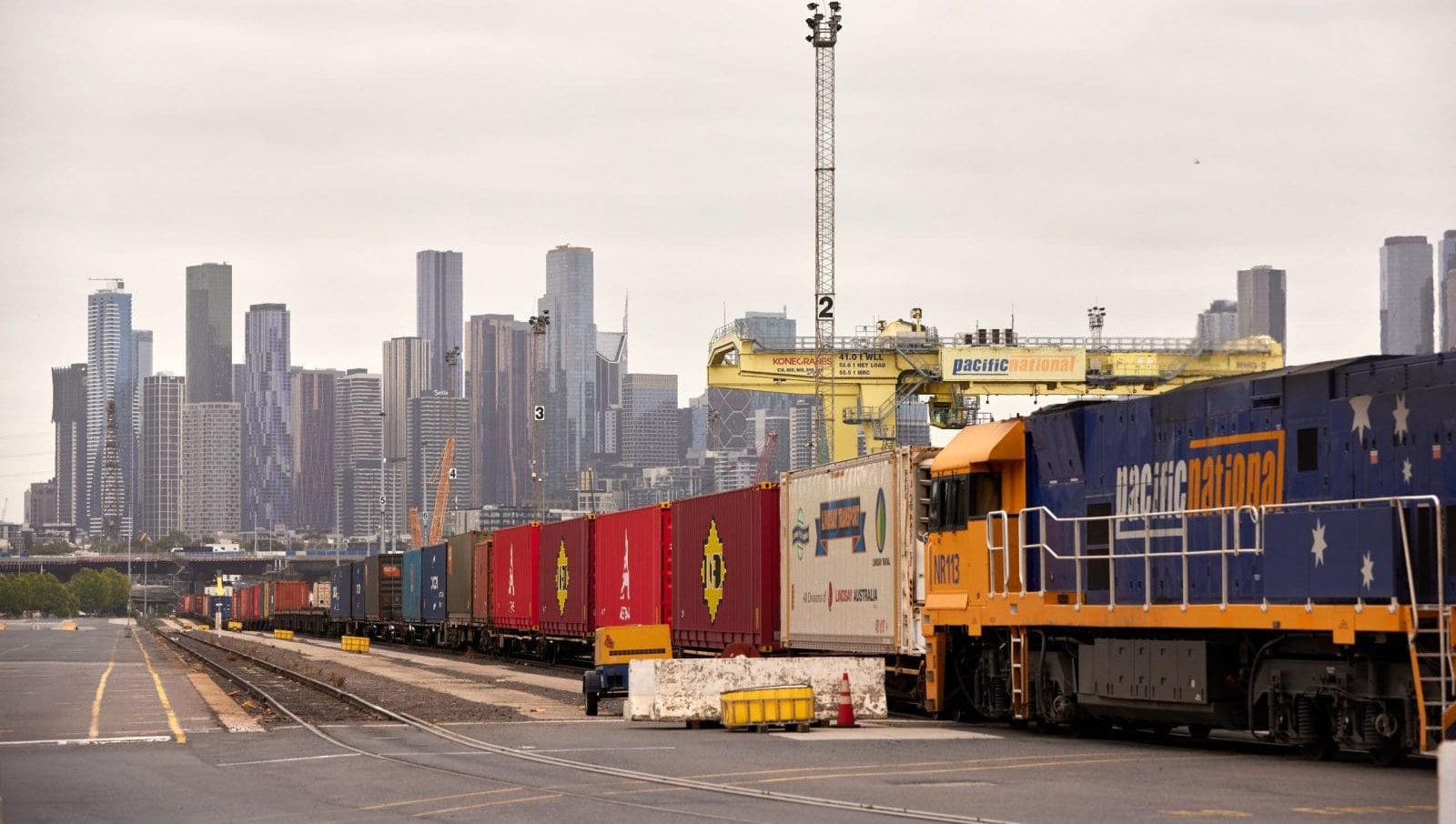
ARTC acting CEO Wayne Johnson, Pacific National managing director and CEO Paul Scurrah, Federal Minister Catherine King and ARA general manager rail freight Georgia Nicholls and general manager advocacy Simon Bourke.
URGENT action is needed to increase rail’s share of freight to meet future transport needs, reduce emissions and foster economic growth, a new research project has concluded.
Federal Minister for Infrastructure, Transport, Regional Development and Communities, Catherine King, together with the Australasian Railway Association and key industry representatives, released the research last week at Pacific National’s intermodal terminal in Melbourne.
The rail industry also launched the Future of Freight campaign in response to the research, which makes several key recommendations for industry and government to enable rail to play a far greater role in Australia’s growing freight task.

Federal Minister for Infrastructure, Transport, Regional Development and Communities, Catherine King.
The campaign is centred on research, which was led by the Australasian Centre for Rail Innovation, with input from the ARA and Freight on Rail Group, and supported by the Department of Infrastructure, Transport, Regional Development, Communications and the Arts.
ARA CEO Caroline Wilkie said the research found the underutilisation of rail freight was a missed opportunity that was costing the Australian economy and stands in the way of reaching net-zero targets.
“Our freight task is significant and growing and we need a resilient, reliable and efficient national rail freight network to support the economy and community,” Ms Wilkie said.
“Road and shipping cannot alone meet this demand, and new policies and more strategic investment is needed to support greater use of rail.”
Rail benefits
Previous ARA research shows that a 10-percent mode shift away from road to rail between major capital cities in Australia will reduce the social costs created through emissions, crashes and accidents, and health costs from emissions, with total estimated benefits of more than $700 million per year.
Rail’s share of inter-capital freight is only 11pc across the eastern seaboard, and as little as 2pc on Australia’s busiest freight corridor between Melbourne and Sydney, the research showed.
At 28pc, less than one third of freight is on rail between Melbourne and Brisbane, the future service area for the Inland Rail project.
FORG chairman and Aurizon managing director and CEO Andrew Harding said boosting the role of rail freight on key interstate freight routes, particularly Melbourne-Sydney-Brisbane, should be a key focus for governments and the rail industry.
“The pandemic illustrated the essential role of a strong national supply chain and the importance of rail as part of our national network, but more investment is urgently needed to increase the resilience and productivity of the network,” Mr Harding said.
“Melbourne-Sydney-Brisbane is a corridor where rail can do the heavy lifting for customers and the economy, while significantly reducing carbon emissions for the transport sector.
“Rail freight is up to 16 times less carbon intensive than road freight.”
Some of the constraints identified as hampering rail’s share of freight include:
- A lack of a “level playing field” between modes, making it harder to compete with road;
- Lack of interoperability between jurisdictions – rail operators using multiple networks to have to manage seven different regulatory frameworks;
- Poor harmonisation of safety standards, operating rules and processes and regulations;
- Rail infrastructure gaps impacting transit time, reliability and availability;
- No national body to mandate harmonised principles, standards and processes;
- Lack of transparent freight data and accurate cost benefit analysis in determining private and public investments infrastructure.

Pacific National’s intermodal terminal in Melbourne.
Reliability is key
ARTC’s acting CEO Wayne Johnson said rail was a vital link in the national supply chain and an effective mechanism for government and industry to work towards contributing to the net-zero targets by 2050.
“This report highlights that a robust and effective rail network can only strengthen our supply chains and enable growth of our markets to compete in the global economy,” Mr Johnson said.
“To this end, investment is continuing to improve the resilience and reliability of the freight rail network on the back of unprecedented flooding events.
“However, there is more to do so that rail operators, customers and businesses have confidence in the reliability of rail services, aligning to their expectations.”
The research suggests several practical steps to increasing mode share of rail, including:
- Establishing a national rail regulator to enable mandatory, consistent standards;
- Investments in infrastructure with a focus on resilience and reliability initiatives;
- Enhanced collection of road and rail use and train-service reliability data; and,
- A review of cost-benefit analyses to ensure economic, social and environmental benefits are fully considered in rail/road investment decisions.
Source: ARA, FORG

HAVE YOUR SAY